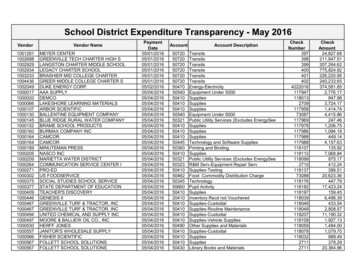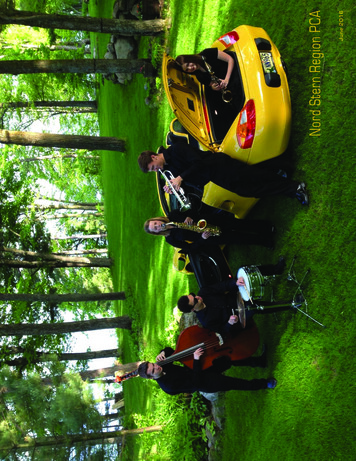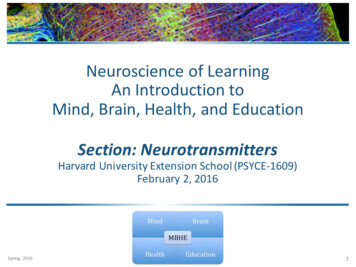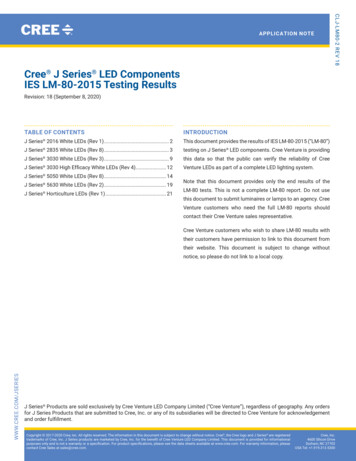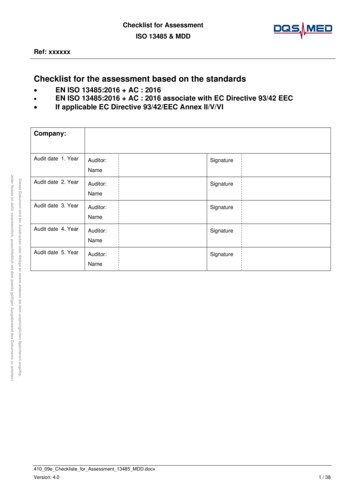
Transcription
AFRL-AFOSR-JP-TR-2016-0059Optical material researches for frontier optical ceramics and visible fiber laser technologiesYasushi FujimotoOsaka University07/07/2016Final ReportDISTRIBUTION A: Distribution approved for public release.Air Force Research LaboratoryAF Office Of Scientific Research (AFOSR)/ IOAArlington, Virginia 22203Air Force Materiel Command
FORM SF 298Page 1 of 1REPORT DOCUMENTATION PAGEForm ApprovedOMB No. 0704-0188The public reporting burden for this collection of information is estimated to average 1 hour per response, including the time for reviewing instructions, searching existingdata sources, gathering and maintaining the data needed, and completing and reviewing the collection of information. Send comments regarding this burden estimate orany other aspect of this collection of information, including suggestions for reducing the burden, to Department of Defense, Executive Services, Directorate (0704-0188).Respondents should be aware that notwithstanding any other provision of law, no person shall be subject to any penalty for failing to comply with a collection of informationif it does not display a currently valid OMB control number.PLEASE DO NOT RETURN YOUR FORM TO THE ABOVE ORGANIZATION.1. REPORT DATE (DD-MM-YYYY)2. REPORT TYPEFinal07-07-20164. TITLE AND SUBTITLEOptical material researches for frontier optical ceramics and visible fiber lasertechnologies3. DATES COVERED (From - To)18 Apr 2013 to 17 Apr 20165a. CONTRACT NUMBER5b. GRANT NUMBERFA2386-13-1-40985c. PROGRAM ELEMENT NUMBER61102F6. AUTHOR(S)Yasushi Fujimoto5d. PROJECT NUMBER5e. TASK NUMBER5f. WORK UNIT NUMBER7. PERFORMING ORGANIZATION NAME(S) AND ADDRESS(ES)Osaka University1-1 YamadaokaSuita, Osaka, 565-0871 JP8. PERFORMING ORGANIZATIONREPORT NUMBER9. SPONSORING/MONITORING AGENCY NAME(S) AND ADDRESS(ES)AOARDUNIT 45002APO AP 96338-500210. SPONSOR/MONITOR'S ACRONYM(S)AFRL/AFOSR IOA11. SPONSOR/MONITOR'S REPORTNUMBER(S)AFRL-AFOSR-JP-TR-2016-005912. DISTRIBUTION/AVAILABILITY STATEMENTA DISTRIBUTION UNLIMITED: PB Public Release13. SUPPLEMENTARY NOTES14. ABSTRACTWe have successfully developed a new technology of visible fiber laser, Pr-doped waterproof fluoro-aluminate glass fiber(Pr:WPFGF) laser. The significant achievements are as follows; 1) greater than 1-W and multi-color visible fiber laser oscillations, 2)visible laser pulse generation in a Pr-doped waterproof fluoride glass fiber using a graphene thin film as a saturable absorber, 3)demonstration of a novel design of a simple and compact tunable visible fiber laser, and 4) for more high power operation,fabrication of a Pr-doped double-clad structured waterproof fluoride glass fiber with a single-mode beam. These results are veryuseful for scientific and industrial applications.15. SUBJECT TERMSFibre Lasers, Laser Dynamics, Nonlinear Optical Materials16. SECURITY CLASSIFICATION OF:a. REPORTb. ABSTRACT c. THIS PAGEUnclassifiedUnclassifiedUnclassified17. LIMITATION OF 18. NUMBERABSTRACTOFPAGESSAR1619a. NAME OF RESPONSIBLE PERSONROBERTSON, SCOTT19b. TELEPHONE NUMBER (Include area code) 81-042-511-7008Standard Form 298 (Rev. 8/98)Prescribed by ANSI Std. isapi.dll9/23/2016
Final Report for AOARD Grant FA2386-13-1-4098“Optical material research for frontier optical ceramics and visible fiber lasertechnologies”Date: 07/7/2016Name of Principal Investigators (PI): Dr. Yasushi FUJIMOTO- e-mail address : fujimoto@ile.osaka-u.ac.jp- Institution : Institute of Laser Engineering, Osaka University- Mailing Address : Yamada-oka 2-6, Suita, Osaka, 565-0871, Japan- Phone : 81-6-6879-8758- Fax : 81-6-6877-4799Name of Principal Investigators (Co-PIs): Dr. Kana FUJIOKA- e-mail address : fujioka-kana@ile.osaka-u.ac.jp- Institution : Institute of Laser Engineering, Osaka University- Mailing Address : Yamada-oka 2-6, Suita, Osaka, 565-0871, Japan- Phone : 81-6-6879-8784- Fax : 81-6-6877-0900Period of Performance:04/18/2013 – 04/17/2016Abstract: We have successfully developed a new technology of visible fiber laser,Pr-doped waterproof fluoro-aluminate glass fiber (Pr:WPFGF) laser. The significantachievements are as follows; 1) greater than 1-W and multi-color visible fiber laseroscillations, 2) visible laser pulse generation in a Pr-doped waterproof fluoride glass fiberusing a graphene thin film as a saturable absorber, 3) demonstration of a novel design of asimple and compact tunable visible fiber laser, and 4) for more high power operation,fabrication of a Pr-doped double-clad structured waterproof fluoride glass fiber with asingle-mode beam. These results are very useful for scientific and industrial applications.Introduction: Recently, many research groups are studying visible lasers because the lightsources are widely applicable for medicine, biology, metrology, optical storage, and displaytechnology. Gas lasers and dye lasers have often been used in such scientific research,however, due to the delicate operation and the progress in nonlinear crystals, secondharmonic generation (SHG) or optical parametric oscillator (OPO) techniques are now themainstream in visible lasers development.The primary visible laser oscillation is still fascinating. Ruby laser is the first laser, ofcourse, also the first visible solid-state laser, but the other primary visible solid-state lasershave not been very successful because of the lack of good excitation sources. On the otherhand, visible semiconductor lasers are well-developed for use in projector devices, and thepower of a GaN laser diode (LD) is increasing more and more, and greater than 1-W blue(445 nm) and green (525 nm) LD packages are now produced by Nichia Corporation. Thesesemiconductor lasers are very useful for excitation sources.The trivalent rare earth ions, especially Pr3 and Dy3 , are very attractive for visiblesolid-state lasers because these generate several transitions in the red, orange, yellow,green, and blue spectral regions. Recently, many research groups have been studying visiblelasers made from fluoride crystals or glasses with Pr3 and Dy3 ions 1-8) because the fluoridematerials show lower phonon energy than the oxide ones; therefore, the luminescentintensity is higher without multiphonon relaxation. In the latest work, 2.9-W of red laserpower was demonstrated in Pr:YLF excited by 2ω-OPS laser 8).In these background, we studied and developed the following technologies.1. High power, over 1-W, Pr:WPFGF laserIn the present solid-state laser, fiber shape is commonly used, for example, Er- or Yb-dopedfiber lasers, due to the excellent excitation efficiency, good output beam pattern, andalignment free design. Thus, fiber lasers have become more popular and more powerful.Based on these fiber shape advantages, several researchers have gotten into developingrare earth-doped fluoride fiber lasers. Smart et al. demonstrated a visible fiber laser with aZBLAN glass excited by an Ar ion laser at 476.5 nm 1). A tunable fiber laser was alsodemonstrated in Pr:ZBLAN fiber excited by GaN-LD 2). But ZBLAN glass fibers have poorchemical durability, especially that they are soluble in water. Thus a waterproof fluorideDISTRIBUTION A. Approved for public release: distribution unlimited.
glass fiber is keen to be developed. For this purpose, we have successfully drawn rareearth-doped waterproof fluoro-aluminate glass fibers (RE:WPFGF) with low loss (0.1 0.3dB/m) and demonstrated over 1-W multi-color laser oscillation in Pr:WPFGF excited byGaN-LDs.2. Visible laser pulse generation in a Pr-doped waterproof fluoride glass fiber using agraphene thin film as a saturable absorberVisible pulse generation, especially in a primary visible solid-state laser, is a very attractiveresearch object. J. M. Sutherland et al. demonstrated 400-fs pulse laser in Pr:YLF using theKerr-Lens mode-locking technique 9). Several kinds of saturable absorbers (SA) have beendeveloped so far, including SESAM 10) and carbon nano-tube 11), which are often used ininfrared mode-locked pulse lasers. The switching speed of a graphene SA was measured tobe in the femtosecond range 12). Since graphene makes a unique zero-gap linear bandstructure called Dirac cones, the absorbance is independent on the wavelength 11), andtherefore, graphene has the possibility to work as an effective SA in the visible region.However, this kind of visible pulse laser with graphene SA has not been reported yet. Wesuccessfully demonstrated orange short pulse generation in Pr:WPFGF using a graphene thinfilm as a SA. The shortest pulse duration of 9.7 ns was observed in orange color. This resultshows that a graphene thin film is an effective material as a SA switching device for visiblepulse lasers.3. Demonstration of a novel design of a simple and compact tunable visible fiber laserInteraction between light and material is closely related to light wavelength; therefore,tunable lasers are widely used in many applications, for example, medicine, biology, andoptical measurement systems. Generally, lasers emit at a single frequency; however, a lasermedium with a broad emission spectrum, such as a laser dye or luminescent glass, canproduce a tunable laser combined with a spectroscopic system, such as a grating or prism.In the following section, we propose and demonstrate a very simple way to achieve atunable laser skillfully using the chromatic aberration of a lens relay and a slit-like effect ofthe optical fiber core.4. Pr-doped double-clad structured waterproof fluoride glass fiber with single-mode beamIf we want more powerful visible fiber lasers, the increment of excitation power is animportant factor. The most favorable excitation source for a solid-state laser is a laser diodebecause it directly changes electrical power to optical power with high efficiency. However,to increase the power of LDs, we have to provide sufficient beam quality for enlarging theemitter size of LDs. The most effective solution for using high-power LDs efficiently is toadopt a double-clad (DC) structure of the fiber cross-section. The DC structured fiber has aninner-clad surrounding a core that propagates a laser light. The inner-clad surrounded by anouter-clad is designed to accept the LD excitation source with low beam quality, and theexcitation beam is effectively absorbed by core material through the inner-clad. The DCstructured fiber is an effective way to maintain the beam quality of the fiber laser and to usethe low beam quality excitation source. Now, many types of DC fiber cross-sections havebeen presented, such as D-shape and flower shape, and the DC structured fiber has becomethe standard of the fiber cross-section for high-power fiber lasers. Therefore, it is importantnot only to make progress on GaN-LD power but also to develop a DC structured fiber invisible fiber laser material in order to get higher visible fiber laser power. So we report that aPr-doped double-clad structured waterproof fluoride glass fiber (Pr:DC-WPFGF) wassuccessfully drawn, and the laser oscillation was demonstrated. The Pr:DC-WPFGF wasdesigned to be a single-mode fiber and the beam-quality factor, M2, was measured andevaluated to be 1.0.Experiment: Waterproof fluoride glasses in an AlF3 system have been proposed by Iqbal etal. 13) and Kanamori et al. 14) An AlF3 system fluoride glass is 500 times as water-resistant asZBLAN glass 13). Though many research groups have undertaken to draw an optical fiberfrom waterproof glass compositions (AlF3 system), it has proven difficult to draw an opticalfiber at low loss 14). Finally, our group has successfully drawn the optical gain medium fiberswith the properties of waterproof, low loss, and high concentration of rare earth ions.1. High power, over 1-W, Pr:WPFGF laserTo get a more powerful laser that exceeds 1-W, firstly, the power of two GaN-LDs wascombined by polarization beam splitter (PBS). Next, as a pulse operation mode was testedDISTRIBUTION A. Approved for public release: distribution unlimited.
for increasing the output peak power, two GaN-LDs of 1.6-W rating were operated toprovide the maximum peak power of 2.4 W at 5 Hz with 50% duty (100-ms on/off). We callthis operation mode “overdrive pulse mode.” All the Pr:WPFGFs with 3000 ppm of Prconcentration were used as laser media. The Pr:WPFGF was fastened in a zirconia ferrule.The fiber core diameters, fiber lengths and reflectivity of output mirrors are listed in Table 1(in Results and Discussion section). The pump source was a GaN-LD (NICHIA Corporation:NDB7875, 1.6-W) at 442 nm which is corresponding to the absorption peak of thePr:WPFGF. The experimental setup of the Pr:WPFGF laser oscillation is illustrated in Fig.1.Fig.1 The setup of Pr:WPFGF laser excited by two-polarization-combined GaN-LDs2. Visible laser pulse generation in a Pr-doped waterproof fluoride glass fiber using agraphene thin film as a saturable absorberThe experimental setup for the visible pulse laser oscillator and a photograph of thetranscribed graphene thin film on a dielectric cavity output mirror are shown in Fig. 2. Acommercially available single layer graphene on copper foil (Graphene Laboratory Inc.) wasused in this experiment. In order to remove the film from the copper foil, the single layergraphene on copper foil was dipped in a 5% iron (III) nitrate water solution, and then thedetached graphene was transcribed on a dielectric cavity output mirror (Fig. 2).Fig. 2 Experimental setup for Pr:WPFGF visible pulse laser oscillator and a photographof transcribed graphene thin film on a dielectric cavity output mirror. a) Focus spot forCW laser operation and b) Focus spot for pulse laser operation.Next, we tested the CW laser operation at 603 nm with the experimental setup. APr:WPFGF was fixed in a zirconia ferrule. The Pr concentration of the fiber core was 3,000ppm. The fiber’s core diameter was 8 μm and 40 mm long. Its numerical aperture wascalculated to be 0.234 at 603 nm. Since its V-number was calculated to be 9.53 (6.2(π/2)) at603 nm, the fiber was multimode. A GaN-LD (NICHIA Corp.: NDB7875, 1.6-W) was used asan excitation source, and the wavelength was 442 nm, which corresponds to the absorptionDISTRIBUTION A. Approved for public release: distribution unlimited.
peak of the Pr:WPFGF. The excitation surface of the Pr:WPFGF in the zirconia ferrule has ahigh reflection dielectric multilayered coating (R 99.9%@603nm), and the other endsurface was non-coated; 3.5% loss through the non-coated surface was estimated. Thefiber’s output beam was focused on the graphene transcribed mirror (Edmund Optics;#64603, R 99.1%@603 nm) by an aspheric lens relay (Edmund Optics; #49104, f 37.5mm). The cavity length and the single pass optical distance were 191 and 216 mm,respectively. The laser pulses were measured on a Si-photo diode detector (Si-PD;Thorlabs,DET210). The spectrum of the CW laser oscillation was measured by a fiber opticspectrometer (Ocean Optics; HR2000).3. Demonstration of a novel design of a simple and compact tunable visible fiber laserA tunable laser is a light source that has coherence and wavelength selectivity. There havebeen many types of tunable lasers. Considering general tunable laser configuration, forexample, Liu & Littman’s 15) tunable laser, we find three essential elements:1) Laser (gain) medium with broad emission spectrum;2) Spatially dispersive optics for broad emission material, such as a grating or prism; and3) Selection mechanism of dispersed light source, such as a slit or mirror with an angleadjuster for a selected wavelength of the light direction.Fig. 3 Configuration of the presented simple and compact tunable laser. 1)-3) representand explain the three elements in the text.Of these elements, 2) and 3) are the bottleneck for a compact and simple tunable lasersystem because the usual dispersive optics require a widespread space. The configuration ofour proposed tunable laser is shown in Fig.3. This configuration also contains the threefollowing tunable laser elements:1) Laser medium: a rare-earth doped active optical glass fiber;2) Dispersive optics: lens relay for spatial dispersion of the light source; and3) Selection mechanism: a slit-like effect of the optical fiber core and the output mirror thatmoves in z-axis (laser output direction) for image relay.Glass material provides a local field of rare-earth elements in its inhomogeneousbroadening of the energy bands in the elements, and therefore, a rare-earth dopedglass fiber can function as a broad luminescent material. The luminescent spectrumof Pr:WPFG is illustrated in Fig.4. As shown in Fig.4, we can apply Pr:WPFG as abroad luminescent material for an optical fiber core. Next, the usual transparentoptics naturally have chromatic aberration; thus, the lens relay can operate asdispersive optics to control the focus length of the cavity. Finally, as the focusingdistance changes with wavelength due to the chromatic aberration, by putting theoutput mirror at the image relay point of the optical fiber core surface for eachcolor, we can select the wavelength with the moving output mirror in the z-axisbecause the fiber core operates like a slit.DISTRIBUTION A. Approved for public release: distribution unlimited.
Fig. 4 Luminescent spectrum of Pr:WPFG.We tested the tunable laser’s operation in an experimental setup as shown in Fig.3. APr:WPFG fiber fixed in a zirconia ferrule was used as a broadband gain fiber. The Prconcentration of the fiber core was 3,000 ppm. The fiber’s core diameter and length were 8μm and 40 mm, respectively. Its numerical aperture was calculated to be 0.233 to 0.234between 600 and 630 nm.A GaN-LD (gallium nitride-laser diode) (NICHIA Corp.: NDB7875, 1.6 W) was used as anexcitation source and the emission wavelength was 442 nm, which corresponds to theabsorption peak of the Pr:WPFG fiber. The excitation surface of the Pr:WPFG fiber in thezirconia ferrule had a high reflection dielectric multilayered coating (R 99.9%, 600-660nm). The other end surface was non-coated and we estimated a 3.5% loss through thenon-coated surface. The fiber output beam was focused on the mirror (Edmund Optics;#47289) with an aspheric lens relay (Edmund Optics; #49104, f 37.5 mm). The cavitylength was 191 mm and the cavity output mirror position of the z-axis was adjusted using astage micrometer. The spectrum of the CW laser oscillation was measured by a fiber opticspectrometer (Ocean Optics; HR2000).4. Pr-doped double-clad structured waterproof fluoride glass fiber with single-mode beamWe tested a CW red laser oscillation with the experimental setup illustrated in Fig. 5. APr:DC-WPFGF was prepared for this experiment. The fiber’s core diameter was 5.2 µm, theinner-clad diameter was 14 µm and the outer-clad diameter was 270 µm. The numericalapertures (NA) of the core and the inner-clad were 0.08 and 0.29, respectively. Since itsV-number is calculated to be 2.045 ( 2.405) at 639 nm, the fiber is expected to be asingle-mode fiber. The Pr concentration of the fiber core was 3,000 ppm. The fiber lengthwas 100.4 mm. Both fiber end surfaces of the Pr:DC-WPFGF have dielectric multilayeredcoatings. The excitation surface has a high reflection mirror (R 99.5%@639 nm,27.3%@600 nm, 4.6%@442 nm (T 95.4%)), and the other end surface has a partialreflection mirror (R 61.7%@639 nm, 2.5%@600 nm, 73.7%@442 nm (T 26.3%)). AGaN-LD (NDB7875E, 1.6-W; NICHIA Corp.) was used as an excitation source, and thewavelength was 442 nm, which corresponds to the absorption peak of the Pr:DC-WPFGF 16).The collimation package includes a collimation lens (f 8.0 mm, NA 0.5) and an anamorphicprism pair with a magnification of 4. The slow axis of GaN-LD was set to the magnifying axisin the anamorphic prism pair. The shaped LD beam was focused onto the Pr:DC-WPFGFexcitation fiber end surface by a focusing lens with a focal length of 14.5 mm and an NA of0.28 (GLC-14.5-8.0-405; CVI). The input-output characteristics of CW red laser power weremeasured by an optical power meter (OPHIR; model 3A) with route a) in Fig. 5. Thespectrum of the CW red laser oscillation was measured by a fiber optic spectrometer (OceanOptics; HR2000).The beam-quality factor of the CW red laser was measured by route b) in Fig. 5. Acollimation lens (f 11.0 mm, NA 0.26; A220TM-A, THORLABS) and a focus lens (f 30.0DISTRIBUTION A. Approved for public release: distribution unlimited.
mm, NA 0.42; #47-633, Edmund Optics) were used. The beam spot size dependence onthe z-axis, which is defined as the laser propagation direction, was measured by amicro-beam profiler (MBP-100-USB; Newport).Fig. 5 Experimental setup for visible fiber laser oscillator in Pr:DC-WPFGF. a) Measurement for input-output characteristics on CW red laser oscillation, and route b) Measurement for beam-quality factor.Results and Discussion:explained as follows.The four significant experimental research advances are1. High power, greater than 1-W, Pr:WPFGF laserThe results are shown in Fig. 6. Greater than 1-W laser oscillations were demonstrated incyan, green and red colors. The visible laser performances with fiber and mirror conditionsare also summarized in Table 1. Orange laser was also demonstrated at 0.52W because ofexistence of self-absorption band (3H4- 1D2). Historical study of Pr-doped primary red laserdevelopment is shown in Fig. 7. Our result of 1.8 W high-power red fiber is still the worldrecord in primary red fiber lasers.Fig. 6 Visible Pr:WPFGF laser characteristics. Launched power includes coupling andabsorption losses.Table 1 Summary of visible laser performances with fiber and mirror conditions.Oscillation wavelength [nm]Maximum power [W]Slope efficiency [%]Maximum Conversion efficiency [%]Threshold power [mW]Core diameter [µm]Fiber length [mm]Reflectivity of output mirror 1Red638.61.8041.738.4282146060DISTRIBUTION A. Approved for public release: distribution unlimited.
Fig. 7 Historical study of Pr-doped primary red laser development. Green circles are ourresults.2. Visible laser pulse generation in a Pr-doped waterproof fluoride glass fiber using agraphene thin film as a saturable absorberThe input-output characteristics of the CW operation are shown in Fig. 8. As shown in Fig. 2,the graphene transcribed mirror had parts with and without graphene thin film. When wedemonstrated the CW laser oscillation, we used the mirror part without graphene thin film(Fig. 2, part a)). In this case, we did not observe any pulse generation. When the launchedpower was 522 mW at the maximum, the observed output power was 1.0 mW. The peakoscillation wavelengths were 603 nm.Fig. 8 Orange CW input-output characteristicsNext, we tested the pulse laser generation. When we demonstrated it, we used themirror part with graphene thin film (Fig. 2, part b)). As the graphene SA properties were notuniform in the graphene thin film area, we searched for suitable points of the transcribedgraphene thin film on the cavity output mirror by moving the mirror in the x-y plane (z-axisDISTRIBUTION A. Approved for public release: distribution unlimited.
means the direction of the light propagation). Finally, we observed two modes of laseroscillation pulses (Figs. 9a and b).One operation mode was the continuous pulse generation shown in Fig. 9a. The pulserepetition period was 2.61 µs, and the pulse duration’s FWHM was 0.47 µs (Fig. 9a). In thisexperiment, since the SA properties of the transcribed graphene were not uniform in the filmarea on the mirror (as explained above), the pulse repetition periods and the pulse durationswere slightly different from all the places, and the possibility of the existence of two or morepulse repetition periods was also shown in another place observation. Therefore, in thisreport, we illustrated a typical continuous pulse, as shown in Fig. 9a.The second pulse operation is a suddenly generated giant pulse with a moving x-y planeof graphene thin film on the mirror. This is a single pulse (Fig. 9b). In this measurement,there was an additional OD2 filter (1% transmittance) in front of the Si-PD detectorcompared to the experimental setup of the continuous pulse generation, and the pulse peakintensity was ten times larger than the continuous pulse peak without an OD2 filter.Therefore, we estimated that the giant pulse is three orders of magnitude larger than thecontinuous pulse peak. The pulse duration of the giant single pulse was measured to be 9.7ns at 522 mW blue LD excitation, and the duration was much less than the continuous one.abFig. 9 Pulse laser generation in Pr:WPFGF.a Continuous pulse generation modeb Single giant pulse generation modeDISTRIBUTION A. Approved for public release: distribution unlimited.
These two pulse generation mechanisms are obviously different. The former corresponds tothe switching process of a few percent of breaching of the graphene thin film. Theaccumulated energy in the oscillation cavity by CW excitation is expressed by theconvolution of the CW excitation power with radiative decay:.(1)Here we estimate the rate of the pulse output energy to the maximum energy confined inthe cavity using 51.3 µs of the Pr:WPFG lifetime 17). Since the cavity with graphene switchedand released the stored energy pulses every 2.61 µs, the pulse energy’s maximum rate iscalculated to be less than 5.0% of the maximum cavity energy. Since the repetition period ofthe 2.61 µs is much longer than the round trip time of the cavity (1.44 ns), the pulse wasgenerated by a cavity dumping process.On the other hand, the latter mechanism may correspond to the switching of the nearlyfull breaching of the graphene thin film. Wagner et al. reported that the pulse durationbecomes shorter as the rate of the initial state population inversion density to the thresholdstate one increases 18). Thus, the following three situations are considered: 1) the case thatthe initial population inversion state of the giant single pulse in our experiment is larger thanthe continuous pulse, or 2) the case that the threshold state population inversion density ofthe giant single pulse is smaller than that of continuous pulse, or 3) the mixed situation ofthe both above cases. The importance of understanding this phenomenon is also supportedby the fact that the giant pulse peak intensity is three orders of magnitude larger than thecontinuous pulse peak intensity. If we can control the switching process with graphene thinfilm, such understanding may give variety of pulse generations.Fluoride glass materials show about 10-20 nm of spectral bandwidth 17), and thebandwidth is wide enough for generating ultra-short pulse lasers. According to previousresearch12), the switching speed of the graphene that reaches femtoseconds and thisbroadband spectrum property of fluoride glass materials help us to demonstrate a primaryvisible ultra-short pulse laser with a mode-locking technique by a graphene SA.3. Demonstration of a novel design of a simple and compact tunable visible fiber laserFigure 10 shows the experimental results of the tunable properties. The wavelengthlengthens as the cavity length increases. Only 130 µm of z-axis moving distance wasrequired to obtain about 20 nm of tunability.Fig.10 Experimental result of the presented simple and compact tunable laser.By applying the chromatic aberration of the lens relay to dispersive optics, we created asimple and compact tunable laser. The z-axis moving distance to obtain 20 nm of tunabilitywas only 130 µm. This 130 µm of moving distance is a very distinctive value because it ismuch smaller than that of tunable laser systems with gratings and is much larger than thatDISTRIBUTION A. Approved for public release: distribution unlimited.
with an etalon in nm-order precision. Therefore, there is no need for a larger space orcomplicated and high precision devices.This configuration, as shown in Fig.3, has other merits as well. First, if we put anappropriate saturable absorber on the output mirror, such as a graphene, carbon nanotube,or SESAM (semiconductor saturable absorber mirror), the laser can operate as a Q-switch 19)or mode-locked tunable fiber laser. Second, we only demonstrated this laser betweenorange and red, but this method can be easily used for any wavelength that has active fiberlasers, such as Pr (0.48, 0.52, 0.61, 0.64, 0.72 µm), Nd (1.06 µm), Yb (1.03 µm), Er (1.55µm), and Tm (2.0 µm). Third, this method can also be applied to waveguide-type gainmedia, such as semiconductor waveguides.4. Pr-doped double-clad structured waterproof fluoride glass fiber with single-mode beamThe input-output characteristics of the CW red laser oscillation are shown in Fig. 11. Themaximum output power was measured to be 251.7 mW at 701.1-mW GaN-LD excitation.The slope efficiency and threshold power were calculated to be 43.4% and 120.6 mW,respectively. The absorbed excitation GaN-LD power in the Pr:DC-WPFGF was estimated tobe 90% of launched GaN-LD power.Fig. 11 Input-output characteristics of CW red laser oscillation.Fig. 12 Spectrum of CW red laser oscillation in Pr:DC-WPFGF.DISTRIBUTION A. Approved for public release: distribution unlimited.
The measured spectrum of CW red laser oscillation is illustrated in Fig. 12. The peakwavelength and spectral width of FWHM were measured as 639.0 nm and 2.3 nm. Thebeam spot size dependence on the z-axis of the Pr:DC-WPFGF laser is illustrated in Fig. 13.The beam-quality factors 20) were evaluated in horizontal and vertical axes. The beam radiuswas described as Eq. (2).(2)where W(z) is beam radius at z, W0 is beam waist radius, and zR is Rayleigh range.Rayleigh range was expressed as the following equation.(3)where λ is wavelength, M2 is beam-quality factor. The beam-quality factors in horizontal andvertical axes are evaluated to be M2horizontal 1.04 and M2vertical 1.00; therefore, it isconsidered that the output laser beam from Pr:DC-WPFGF is confirmed a
power of GaN laser diode (LD) is increasing more and more, a greater thanand 1-W blue (445 nm) and green (525nm) LD packages are now produced by Nichia Corporation. These semiconductor lasers are very useful for excitation sources. The trivalent rare earth ions, espe

